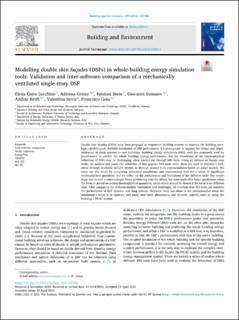| dc.contributor.author | Catto Lucchino, Elena | |
| dc.contributor.author | Gelesz, Adrienn | |
| dc.contributor.author | Skeie, Kristian | |
| dc.contributor.author | Gennaro, Giovanni | |
| dc.contributor.author | Reith, András | |
| dc.contributor.author | Serra, Valentina | |
| dc.contributor.author | Goia, Francesco | |
| dc.date.accessioned | 2021-05-25T07:31:51Z | |
| dc.date.available | 2021-05-25T07:31:51Z | |
| dc.date.created | 2021-05-22T17:56:36Z | |
| dc.date.issued | 2021 | |
| dc.identifier.citation | Building and Environment. 2021, 199, . | en_US |
| dc.identifier.issn | 0360-1323 | |
| dc.identifier.uri | https://hdl.handle.net/11250/2756156 | |
| dc.description.abstract | Double skin façades (DSFs) have been proposed as responsive building systems to improve the building envelope’s performance. Reliable simulation of DSF performance is a prerequisite to support the design and implementation of these systems in real buildings. Building energy simulation (BES) tools are commonly used by practitioners to predict the whole building energy performance, but the simulation of the thermophysical behaviour of DSFs may be challenging when carried out through BES tools. Using an exhaust-air façade case study, we analyse and assess the reliability of four popular BES tools when these are used to simulate a DSF, either through available in-built models or through custom-built representations based on zonal models. We carry out this study by comparing numerical simulations and experimental data for a series of significant thermophysical quantities, and we reflect on the performance and limitations of the different tools. The results show that no tool is outstandingly better performing over the others, but some tools offer better predictions when the focus is placed on certain thermophysical quantities, while others should be chosen if the focus is on different ones. After comparing the different models’ limitations and challenges, we conclude that BES tools can simulate the performance of DSF systems over long periods. However, their use alone is not recommended when the simulation’s scope is to replicate and study short-term phenomena and dynamic aspects, such as sizing the building’s HVAC system. | en_US |
| dc.language.iso | eng | en_US |
| dc.publisher | Elsevier Science | en_US |
| dc.rights | Navngivelse 4.0 Internasjonal | * |
| dc.rights.uri | http://creativecommons.org/licenses/by/4.0/deed.no | * |
| dc.title | Modelling double skin façades (DSFs) in whole-building energy simulation tools: Validation and inter-software comparison of a mechanically ventilated single-story DSF | en_US |
| dc.type | Peer reviewed | en_US |
| dc.type | Journal article | en_US |
| dc.description.version | publishedVersion | en_US |
| dc.source.pagenumber | 25 | en_US |
| dc.source.volume | 199 | en_US |
| dc.source.journal | Building and Environment | en_US |
| dc.identifier.doi | 10.1016/j.buildenv.2021.107906 | |
| dc.identifier.cristin | 1911437 | |
| dc.relation.project | Norges forskningsråd: 262198 | en_US |
| dc.description.localcode | This is an open access article distributed under the terms of the Creative Commons CC-BY license, which permits unrestricted use, distribution, and reproduction in any medium, provided the original work is properly cited. | en_US |
| dc.source.articlenumber | 107906 | en_US |
| cristin.ispublished | true | |
| cristin.fulltext | original | |
| cristin.qualitycode | 2 | |

